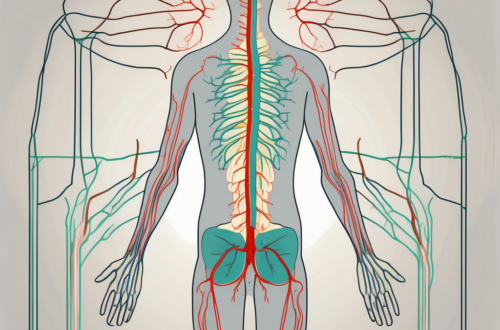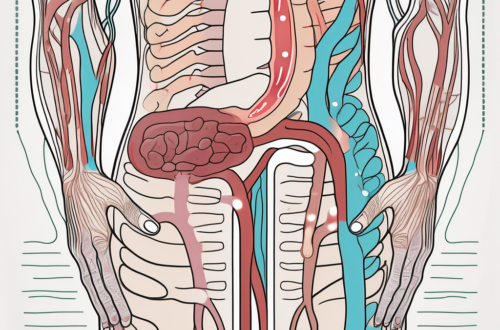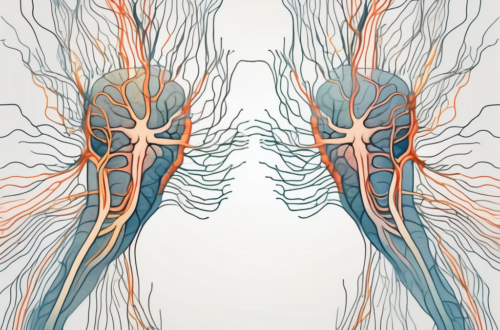The heart is a vital organ responsible for pumping blood throughout the body. Its function is regulated by a complex network of nerves that help maintain a balance between the sympathetic and parasympathetic nervous systems. In this article, we will explore the areas of the heart that are innervated by parasympathetic nerve fibers and the role they play in heart function.
Understanding the Parasympathetic Nervous System
The parasympathetic nervous system is one of the divisions of the autonomic nervous system. It works in opposition to the sympathetic nervous system, which is responsible for the “fight or flight” response. The parasympathetic nervous system, on the other hand, is responsible for promoting rest, relaxation, and digestion.
One of the key components of the parasympathetic nervous system is the vagus nerve, which innervates many different organs in the body, including the heart.
The parasympathetic nervous system plays a crucial role in maintaining homeostasis, or the body’s internal balance. It helps regulate various bodily functions such as heart rate, digestion, and respiration. By stimulating parasympathetic activity, the body can conserve energy and promote a state of relaxation.
It is important to note that the parasympathetic nervous system’s effects are generally more localized and specific compared to the broader effects of the sympathetic nervous system.
The parasympathetic innervation of the heart primarily occurs through the vagus nerve. The vagus nerve sends branches that innervate different areas of the heart, including the sinoatrial (SA) node, atrioventricular (AV) node, and the coronary arteries.
These parasympathetic nerve fibers release the neurotransmitter acetylcholine, which binds to specific receptors in the heart and regulates heart rate and contraction.
In addition to its role in regulating heart rate and contraction, the parasympathetic nervous system also influences other aspects of cardiovascular function. For example, it helps to maintain proper blood pressure levels by promoting vasodilation, or the widening of blood vessels. This allows for increased blood flow and oxygen delivery to various tissues and organs.
Furthermore, the parasympathetic nervous system is involved in the regulation of digestion. When activated, it stimulates the production of digestive enzymes and increases blood flow to the digestive organs, promoting efficient nutrient absorption and waste elimination.
Another important function of the parasympathetic nervous system is its role in promoting rest and relaxation. Activation of the parasympathetic system leads to a decrease in heart rate, blood pressure, and respiratory rate. It also helps to relax smooth muscles in the gastrointestinal tract, promoting digestion and reducing feelings of stress and anxiety.
Overall, the parasympathetic nervous system plays a vital role in maintaining the body’s internal balance and promoting a state of rest, relaxation, and optimal digestion. Its effects on the heart, blood vessels, and digestive system are essential for overall health and well-being.
Anatomy of the Heart and Nervous System
To better understand the innervation of the heart by the parasympathetic nervous system, let’s briefly review the anatomy of the heart and its connection to the nervous system.
The heart, an incredible organ, is a muscular powerhouse located in the chest cavity. It is divided into four chambers: two atria and two ventricles. These chambers work together in perfect harmony to ensure the continuous circulation of blood throughout the body. The atria receive blood from various parts of the body, while the ventricles pump the blood out to its intended destinations.
But what protects this vital organ? The heart is surrounded by a protective sac called the pericardium, which acts as a shield against external forces. It’s like a knight’s armor, safeguarding the heart from any potential harm.
Overview of Heart Anatomy
Now, let’s delve deeper into the fascinating structure of the heart. Beyond its chambers, the heart is composed of specialized muscle tissue called myocardium. This unique tissue is responsible for the heart’s incredible ability to contract and pump blood throughout the body. It’s like a symphony orchestra, with each muscle fiber playing its part to create a harmonious rhythm.
Within the myocardium, there is an intricate network of blood vessels known as coronary arteries. These arteries supply the heart muscle with oxygen and nutrients, ensuring its proper function. They are like the lifelines of the heart, providing it with the nourishment it needs to keep beating.
Nervous System and Its Connection to the Heart
Now that we have explored the intricate anatomy of the heart, let’s shift our focus to its connection with the nervous system. The heart, being a vital organ, receives its nerve supply from the autonomic nervous system, which controls involuntary bodily functions.
This autonomic nervous system is further divided into two divisions: the sympathetic and parasympathetic divisions. Both divisions play essential roles in regulating the heart’s activity, ensuring its proper function at all times.
The sympathetic nerves, originating from the thoracic spinal cord, are like the gas pedal of the heart. When activated, they increase heart rate and contractility, preparing the body for times of stress or physical exertion. It’s like a turbo boost, giving the heart the extra power it needs to meet the demands of the body.
On the other hand, the parasympathetic nerves, originating from the brainstem, act as the brakes, counterbalancing the sympathetic activity. They help restore the heart to its resting state, reducing heart rate and promoting relaxation. It’s like a soothing lullaby, calming the heart after a long day’s work.
Together, the sympathetic and parasympathetic divisions of the autonomic nervous system maintain a delicate balance, ensuring that the heart functions optimally in various situations. It’s like a well-choreographed dance, with each division playing its part to keep the heart in perfect rhythm.
So, next time you feel your heart race or experience a moment of tranquility, remember the intricate connection between the heart and the nervous system. It’s a remarkable partnership that allows us to live and thrive.
Parasympathetic Innervation of the Heart
Now that we have a basic understanding of the heart’s anatomy and its connection to the nervous system, let’s delve deeper into the parasympathetic innervation of the heart and the role of the vagus nerve.
The parasympathetic innervation of the heart plays a crucial role in regulating its function and maintaining a balance between sympathetic and parasympathetic activity. The vagus nerve, also known as the tenth cranial nerve, is the primary parasympathetic nerve that innervates the heart. It originates in the medulla oblongata, a region of the brainstem responsible for controlling many autonomic functions.
The vagus nerve sends branches to different areas of the heart, including the sinoatrial (SA) node, atrioventricular (AV) node, and the coronary arteries. These branches contain parasympathetic fibers that modulate heart rate, conduction velocity, and contractility.
The Vagus Nerve and Its Role
The vagus nerve, with its intricate network of fibers, plays a vital role in maintaining the balance between sympathetic and parasympathetic activity in the heart. It acts as a regulator, ensuring that the heart functions optimally under various physiological conditions.
Originating in the medulla oblongata, the vagus nerve extends its branches to the SA node, which is often referred to as the natural pacemaker of the heart. The parasympathetic fibers of the vagus nerve release a neurotransmitter called acetylcholine onto the SA node, resulting in a decrease in heart rate. This decrease in heart rate allows the heart to fill adequately and facilitates efficient blood flow through the cardiac chambers.
In addition to its influence on the SA node, the vagus nerve also affects the AV node, which is responsible for the electrical conduction from the atria to the ventricles. When the parasympathetic system is activated, the vagus nerve slows down the electrical conduction through the AV node. This delay allows the ventricles sufficient time to fill with blood before each contraction, ensuring optimal cardiac output.
Impact of Parasympathetic Innervation on Heart Function
The parasympathetic innervation of the heart has a profound impact on its overall function. When the parasympathetic system is activated, such as during moments of relaxation or rest, the vagus nerve releases acetylcholine onto the SA node, resulting in a decrease in heart rate. This decrease in heart rate not only conserves energy but also allows the heart to function efficiently.
Furthermore, the parasympathetic innervation affects the AV node, slowing down the electrical conduction from the atria to the ventricles. This delay allows the ventricles sufficient time to fill with blood before each contraction, optimizing cardiac output and ensuring effective circulation throughout the body.
Overall, the parasympathetic innervation of the heart, primarily through the vagus nerve, plays a crucial role in maintaining the balance and regulating the function of this vital organ. Understanding the intricate interactions between the nervous system and the heart is essential in comprehending the complex mechanisms underlying cardiovascular health and disease.
Effects of Parasympathetic Stimulation on the Heart
Now that we understand the general effects of parasympathetic innervation on the heart, let’s examine the specific ways in which parasympathetic stimulation affects heart function.
Parasympathetic stimulation plays a crucial role in maintaining the balance of the autonomic nervous system, which controls involuntary bodily functions. When activated, the parasympathetic nervous system releases acetylcholine, a neurotransmitter that binds to specific receptors in the heart and initiates a series of physiological responses.
Heart Rate and Parasympathetic Stimulation
The most prominent effect of parasympathetic stimulation on the heart is the decrease in heart rate. Acetylcholine released by the parasympathetic nerves binds to the SA node, a specialized group of cells in the right atrium that acts as the heart’s natural pacemaker. This binding causes hyperpolarization, a state in which the cell’s membrane potential becomes more negative, reducing its ability to generate electrical impulses. As a result, the SA node fires fewer action potentials, leading to a slower heart rate.
This decrease in heart rate may be beneficial in certain situations, such as when the body requires less oxygen demand, such as during sleep or times of relaxation. By slowing down the heart rate, the parasympathetic system helps conserve energy and promotes a state of calmness and restfulness.
However, excessive parasympathetic stimulation can lead to bradycardia, a condition characterized by an abnormally slow heart rate. Bradycardia can cause symptoms such as dizziness, fatigue, and fainting, and may require medical intervention to restore normal heart rhythm.
Other Cardiovascular Effects of Parasympathetic Stimulation
In addition to heart rate regulation, parasympathetic stimulation also has other noticeable effects on the cardiovascular system. It can cause vasodilation, or the relaxation of blood vessels, which leads to a decrease in blood pressure.
When the parasympathetic system is activated, acetylcholine binds to receptors on the smooth muscle cells lining the blood vessels, triggering a cascade of events that result in their relaxation. As the blood vessels widen, the resistance to blood flow decreases, allowing for improved circulation and a reduction in blood pressure.
Furthermore, parasympathetic stimulation can also influence the release of certain hormones and neurotransmitters that affect heart function, such as norepinephrine and adrenaline. These substances, also known as catecholamines, play a vital role in regulating heart rate, contractility, and blood vessel constriction. By modulating their release, the parasympathetic system contributes to the overall balance and coordination of cardiovascular responses.
It is important to note that while parasympathetic stimulation generally exerts inhibitory effects on the heart, the sympathetic nervous system, its counterpart, has the opposite effect. The sympathetic system, often referred to as the “fight or flight” response, increases heart rate, contractility, and blood pressure, preparing the body for intense physical activity or stress.
In conclusion, parasympathetic stimulation exerts profound effects on the heart, primarily by decreasing heart rate and promoting vasodilation. These responses contribute to the overall regulation of cardiovascular function and help maintain homeostasis in the body. Understanding the intricate interplay between the parasympathetic and sympathetic systems is crucial for comprehending the complex mechanisms underlying heart function and cardiovascular health.
Clinical Implications of Parasympathetic Innervation
Understanding the clinical implications of parasympathetic innervation of the heart is essential for healthcare professionals in diagnosing and managing certain heart conditions.
The parasympathetic nervous system plays a crucial role in regulating the heart’s activity. It is responsible for slowing down the heart rate and promoting relaxation. This system works in opposition to the sympathetic nervous system, which stimulates the heart and prepares the body for action.
Disorders involving the parasympathetic innervation of the heart can manifest in various ways. For example, an overactive parasympathetic system may lead to bradycardia, a condition characterized by an excessively slow heart rate. This can result in symptoms such as fatigue, dizziness, and fainting.
On the other hand, a dysfunction in the parasympathetic system may contribute to tachycardia, or an abnormally rapid heart rate, which can cause palpitations, shortness of breath, and chest discomfort.
It’s worth noting that other factors, such as underlying heart disease, medication side effects, or hormonal imbalances, can also contribute to these conditions. Therefore, a comprehensive evaluation by a healthcare professional is crucial for accurate diagnosis and appropriate treatment.
When evaluating patients with suspected parasympathetic disorders, healthcare professionals will consider various factors. They will assess the patient’s medical history, perform a physical examination, and may order additional tests such as electrocardiograms (ECGs) or Holter monitoring to evaluate the heart’s electrical activity over a period of time.
Treating disorders related to parasympathetic innervation typically involves addressing the underlying cause. This may include lifestyle modifications, such as reducing stress levels, improving sleep quality, and adopting a heart-healthy diet.
Medical interventions, such as medications that regulate heart rate or restore the balance between the sympathetic and parasympathetic systems, may be necessary in certain cases. However, it is important to emphasize that treatment decisions should always be made in consultation with a qualified healthcare professional.
Furthermore, healthcare professionals may recommend certain non-pharmacological interventions to manage parasympathetic disorders. These may include techniques such as deep breathing exercises, meditation, and yoga, which can help promote relaxation and balance the autonomic nervous system.
In some cases, surgical interventions may be considered as a last resort. For instance, in severe cases of bradycardia that do not respond to other treatments, a pacemaker may be implanted to regulate the heart’s electrical impulses and ensure a normal heart rate.
Regular follow-up appointments with a healthcare professional are crucial for patients with parasympathetic disorders. These appointments allow for monitoring of symptoms, adjustment of treatment plans if necessary, and overall management of the condition.
In conclusion, understanding the clinical implications of parasympathetic innervation of the heart is essential for healthcare professionals. By recognizing the various disorders related to parasympathetic innervation and implementing appropriate treatment and management strategies, healthcare professionals can help improve the quality of life for individuals with these conditions.
Future Research Directions in Parasympathetic Innervation
The study of parasympathetic innervation of the heart remains a subject of ongoing research and exploration. As our understanding of the intricate balance between the sympathetic and parasympathetic systems deepens, new research directions emerge.
Unanswered Questions in Parasympathetic Innervation
There are still many unanswered questions regarding the precise mechanisms by which the parasympathetic nervous system regulates heart function. Further research is needed to elucidate the intricate pathways and molecular signaling involved.
Additionally, the interplay between the parasympathetic system and other physiological processes, such as inflammation, immune response, and psychological factors, warrants further investigation.
Potential Innovations in Understanding and Treating Parasympathetic Disorders
Advancements in technology and medical research continue to provide new avenues for understanding and treating parasympathetic disorders. For example, developments in neuroimaging techniques, such as functional MRI, may offer insights into the neural correlates of parasympathetic function in the heart.
Furthermore, advancements in pharmacology and targeted therapies may lead to more effective treatments for disorders related to parasympathetic innervation in the future.
In conclusion, the parasympathetic nervous system plays a crucial role in regulating heart function. The parasympathetic innervation of the heart, primarily through the vagus nerve, helps maintain balance in heart rate, rhythm, and overall cardiac function. Understanding the areas of the heart innervated by parasympathetic nerves and their function is essential in diagnosing and managing certain heart conditions. As research continues to shed light on this complex regulatory system, we can hope for improved diagnostic tools and treatment options for parasympathetic disorders in the future. It is important to consult with a healthcare professional for personalized advice and management of heart-related concerns.





